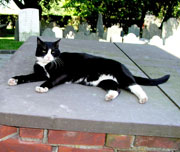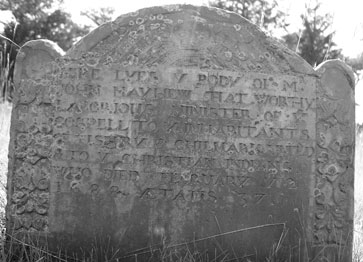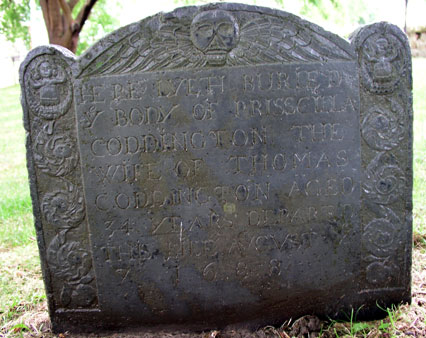Study Guide Reading Gravestones

Table of Contents
2. PARTS OF THE GRAVESTONE
The goal of this page is to teach you to identify
- The main elements of stone
- The main stone shapes
- The main parts of the inscription [Quiz #1] [Quiz #2] and
- Key gravestone symbols [Quiz #3]
A. Elements of the Stone
from Dean Eastman's "Gravestone Glossary," ("Tiptoeing Through the Tombstones" Common-Place. http://www.common-place.org 2(2) January 2002.)
B. Stone Shape
The shape of the stone can provide us with information about the ethnicity, religious denomination, and social status of the deceased. In early New England, three basic stone shapes were commonly used: vertical, horizontal, and obilesques. Each of these stone shapes has specific associations. During the late nineteenth-century, gravestones became more individualistic, and in some garden cemeteries the gravestones were quite unique.
Vertical |
Horizontal |
Obilesque |
|
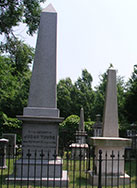 |
|||
| Associations: Vertical stone with a curved top are associated with a curved doorway into the world to come. The
side pillars (“borders”) were seen as analogous to the pillars in the
third temple that harkened of the messianic era. Typically used by: this is the most common shape used in colonial New England. In colonial Jewish cemeteries, they are associated with Ashkenazi Jews. In cemeteries that have a larger than usual proportion of horizontal stones, children are often given a disproportionate number of vertical stones. |
Associations: Horizontal “ledger” stones mark individual
as well as family tombs: beginning in the early 1700s, Protestants sometimes
built underground tombs consisting of a brick burial room covered with
earth and grass. Thus, the above-ground box structures covered by ledger stones mark the site of the tomb,
rather than being the tomb itself (Wells & Wells 20).
Typically used by: Protestant ministers and their families, Sephardic Jews, adults, wealthy members of society who can afford more expensive stones. In Protestant cemeteries, it is not uncommon for this style of stone to mark the tomb of more than one individual. |
Associations: Obilesques became popular in the
nineteenth century and are associated with the Egyptian revival movement.
|
Associations: |
C. Elements of the Inscription
There are seven basic elements found on gravestone inscriptions: (1) Header, (2) Epithet [terms of praise or identifying labels], (3) Name, (4) Formulas of Death, (5) Date, (6) Eulogies [usually hopes for the person in the afterlife], and (7) Age. These elements do not appear on every stone, nor do they always appear in the same order. For example, children’s gravestones often have shorter inscriptions. If you are creating a seriation study, it is useful to identify which element of the inscription you want to track. For example, studies of colonial Protestant stones suggest that the header is the most important locale for understanding theological changes over time.
Sometimes stones contain inscriptions in more than one language. This is
particularly true of immigrants and communities that used more than one
language in their social and religious lives. In these stones, the elements found in the inscriptions, as well
as the order, may vary between the languages. For example, in the Rachel
Lopez’s 1789 gravestone from Newport, RI presented below, the order of the
Hebrew inscription is 6, 1, 2, 3, 4, 5, 7, 6, while the English inscription
is 1, 3, 2, 4, 5, 7, 2. The specifics of the inscription are also different:
the English inscription is more effusive in its epithets of praise, while
the Hebrew inscription relies more heavily upon Biblical quotes.
Examples of each category (not exhaustive):
| 1. Header | Here lies; Here lies the body; In the memory of; Sacred ; The remains of..; etc. |
| 2. Epithet(s) | Honored; Minister; Merchant; Esteemed; Esq[uire]; Daughter of..; Ornament; Faithful Relic of; Mason; etc. |
| 3. Name | Mr. Thomas Mayhew; Moses Lopez |
| 4. Formula of Death | Who departed from this life; Who fell victim to..; who died |
| 5. Date | May 23, 1786; 3 Nissan 5568; ye 2nd of June |
| 6. Eulogies | A Biblical verse; May his soul enjoy the glory; In God we trust |
| 7. Age | Age 3 months and 2 days; Aetatis 62 |
Quiz #1: Identifying Elements of the Inscription (Simple)
Here is the actual stone:
 |
|
John Mayhew (1688); West Tisbury Village Cemetery, Martha's Vineyard,
MA (Photo L. Leibman, 2007) |
Drawing of the John Mayhew Stone from Banks' History
of Martha's Vineyard, I. 504 (1911). |
Practice identifying the parts of the inscription. If you are unsure what element of the inscription something is, see the examples above. Click on CHECK when you are done:
Format
and code for matching quiz borrowed from Donna
M. Campbell's "English
102: Literary Genres" website
Code
produced using Hot Potatoes by Half-Baked Software, registered to Donna
Campbell
Quiz #2: Identifying Elements of the Inscription (Difficult) -Click Here
D. Identifying Key Symbols
The images that appear on gravestone usually have stock associations. The most commonly used gravestone symbols appear on the lunette. These are the death's head, the cherub, and the willow & urn. Scholars have argued persuasively that the shift from the Calvinist “death’s head,” to the Arminian Cherub, to the Unitarian “Urn and Willow” reflect when and how individual communities made the transformation from Calvinism to more liberal forms of Christianity. The change in symbols on the lunette is often reflected in a change in the inscription's header from (1) "Here lies" to (2) "Here lies [buried] the body [corruptible, what was mortal] of" to (3) “in memory of.”
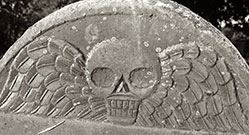 |
 |
 |
Death's Head |
Cherub |
Willow & Urn |
The symbols used on the finials and borders are more diverse. Because images on gravestones are often stylized rather than realistically depicted, it is important to familiarize yourself with how objects are typically represented. Click here to see a gravestone glossary for PROTESTANT cemeteries in New England. Once you have familiarized yourself with the basic symbols, look at the Prisscilla Coddington stone below and identify what symbols are on the lunette, finial, and the borders.
Quiz #3: Identifying Symbols on the Gravestone
 |
|
Prisscilla Coddington Gravestone
(1668), Newport RI (Photo L. Leibman, 2007) |
|
Lunette:_____________________________________
Finial:______________________________________
Borders:_____________________________________ Click here to see the answers
It is is equally important to understand the significance of the symbols being used. Create your own gravestone glossary Here are some resources:
- A list of the most common symbols and what they mean from GraveNet.
- A more comprehensive list of symbols and their associations from the Gravestone Studies Association.
- Jessie Lie Farber's "Early American Gravestones" (Farber Collection)


